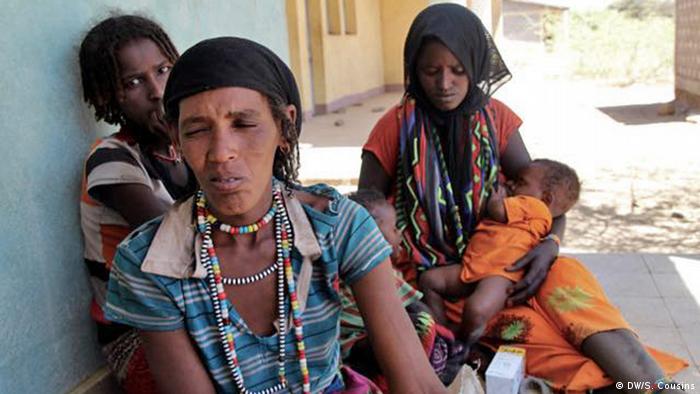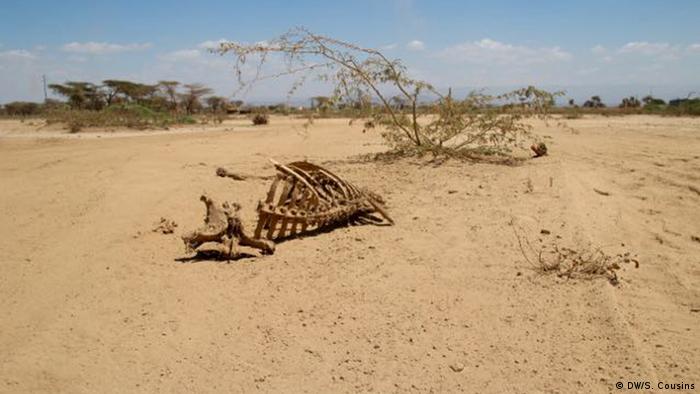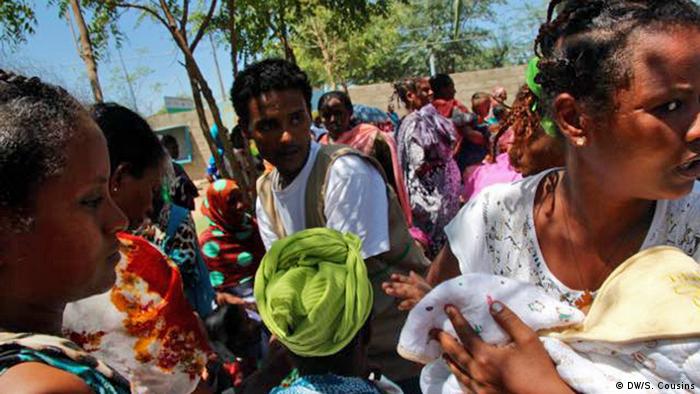Date: Sat, 16 Apr 2016 11:18:35 +0200
Ethiopia on the brink as drought bites
Ethiopia is currently dealing with the worst drought in the region in decades. Lives and livelihoods are at stake, as Sophie Cousins reports from Belaya district.
Author Sophie Cousins, Ethiopia
Date 16.04.2016
Fighting back tears in her mud house in rural Ethiopia, a young woman's son grabs her breast in hope of finding some milk to drink. But there is none.
"We haven't had any rain. We have to sleep without food," Meskerem, 25, told DW as her three-year-old son started crying.
While the jungle here in Sisoyta village in Belaya district, about a five hours' drive from the capital, Addis Ababa, may not look like your typical drought-affected desert, the situation is no less dire. "We have no food to harvest, we have no false banana and no vegetables," Meskerem said.
False banana, a plant native to Ethiopia, is a staple for 15 million people living in the highlands. The stems of the plant are scraped for starch which is then combined with water to eventually turn into kocho, a type of bread.
"If the rain doesn't come soon, I can't cultivate any crops and it's a big problem for me and my children," Meskerem said.
Dependent on agriculture
Ethiopia is currently facing its worst drought in decades after a strong El Nino has blocked two consecutive rainy seasons that normally nourish crops that feed 85 percent of the country.
As a result, more than 10 million people are in need of food assistance, according to UN agencies.
While the country has the fastest growing economy in the world and has been able to lift millions out of poverty, 80 percent of people are still dependent on rain-fed agriculture. But with other international crises dominating donor support such as Syria and refugees fleeing to Europe, international organisations said it has been difficult to raise awareness and subsequent funds for the plight of Ethiopians.
Currently only about half of the $1.4 billion the government and UN agencies need for the response has been raised. "Fundraising for this response has been very slow," said Chege Ngugi, national director of the charity, ChildFund Ethiopia.
"My priority is to support the efforts of the government of Ethiopia to save lives, but we're not reaching everybody," he told DW.
The World Food Programme (WFP) echoed his concerns. Challiss McDonough, regional spokesperson for the WFP, said it could run out of food within two months' time. "We have been calling for urgent funding for months now, and still have only about a quarter of the resources that we need for the next six months. Unless we receive significant new funding very soon, we could start running out of food for relief assistance by May," she told DW.
Malnutrition rates on the rise
Fentale, in the Oromia region of Ethiopia, about 130 km from the capital, is one of the worst-affected areas: the land is arid, rivers are completely dried up, and animal carcasses are strewn across the sand. Here hundreds of mothers in brightly coloured outfits line up at a local centre to have their children measured for malnutrition.
Malnutrition rates in the worst-affected areas of Ethiopia have surpassed 20 percent - higher than the World Health Organisation's (WHO) 15 percent emergency threshold, said WFP. In response, ChildFund is working in Fentale to provide treatment for acute and severe malnutrition. "The river here is completely dry, cows have died and there's no harvest," said Eyoel Lemma, who works at ChildFund Ethiopia, in Fentale.
"Even with interventions the situation is getting worse," he told DW.
Migration is further complicating the response, as farmers and herders walk to look for water and food for their cattle and a new source of income, usually leaving women and children behind. This has made the response even more difficult, NGO workers said, as it's made estimations of those in need of food assistance and malnutrition treatment hard to measure.
Praying for rain
One of those on the move is frail-looking Haso Bultum. For months she's struggled to fed her nine-month-old twins. "There's nothing. To save ourselves we're constantly on the move."
She walked four hours in the blistering sun, with her elderly mother, over mountains to bring her twins to the closest healthcare facility for malnutrition treatment.
"It's very hard. I've had no sleep because we're trying to find some food for our cattle," she told DW.
In response, WFP is planning to support more than two million children, pregnant women and breastfeeding mothers with treatment for moderate acute malnutrition this year. The UN's children's fund, UNICEF, estimates almost 500,000 children are in need of treatment for severe acute malnutrition.
For the time being though, locals are praying the rain, not flooding - which is a major risk after a severe drought - will come soon.
"Soon the rain will come and people's worries will be flooding. But they have nothing except their homes to lose. They've already lost all their animals and crops," Lemma said.


